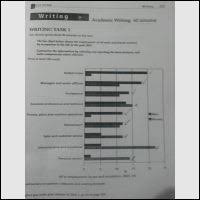juliachung
Mar 14, 2021
Writing Feedback / IELTS TASK 1; The rate of employed British people based on genders in various working fields in 2005 [3]
The bar chart below shows the employment of all male and female workers by occupation in the UK in the year 2005. Summarize the information by selecting and reporting the main features, and make comparisons where relevant.
The bar graph provides the rate of employed British people based on genders in various working fields in 2005. Overall, men took part mostly in technical and required special training careers, whereas women are more favorable in customer service-related professions and working in office.
For high technical skilled jobs, most of the occupations were dominant by males except for associate professional and technical as women were slightly more than men by 2%. In skilled trades, the figure was different among genders, only 2% of working women compared to 20% of that in men. Similarly, for process, plant and machine operatives, the corresponding proportions were around 2% and more than 12%. In comparison, the percentage of women participated in manager and senior officials as well as professional occupations were less significant, at 11%.
In administrative and secretarial areas, on the other hand, had an outbreak in the number of female workers with 22% which was nearly 5 times greater than that of males. Likewise, sales and customer service and personal service experienced the same difference in the number of genders, since the ratio of women to men in the latter is approximately 7 to 1 and for the former, the percentage were 12% in females and about 5 % in males. Laborers and caterers careers are relatively balanced in gender.
EMPLOYMENT OF ALL MALE AND FEMALE WORKERS BY OCCUPATION IN THE UK IN 2005
The bar chart below shows the employment of all male and female workers by occupation in the UK in the year 2005. Summarize the information by selecting and reporting the main features, and make comparisons where relevant.
The bar graph provides the rate of employed British people based on genders in various working fields in 2005. Overall, men took part mostly in technical and required special training careers, whereas women are more favorable in customer service-related professions and working in office.
For high technical skilled jobs, most of the occupations were dominant by males except for associate professional and technical as women were slightly more than men by 2%. In skilled trades, the figure was different among genders, only 2% of working women compared to 20% of that in men. Similarly, for process, plant and machine operatives, the corresponding proportions were around 2% and more than 12%. In comparison, the percentage of women participated in manager and senior officials as well as professional occupations were less significant, at 11%.
In administrative and secretarial areas, on the other hand, had an outbreak in the number of female workers with 22% which was nearly 5 times greater than that of males. Likewise, sales and customer service and personal service experienced the same difference in the number of genders, since the ratio of women to men in the latter is approximately 7 to 1 and for the former, the percentage were 12% in females and about 5 % in males. Laborers and caterers careers are relatively balanced in gender.

download.jpeg
